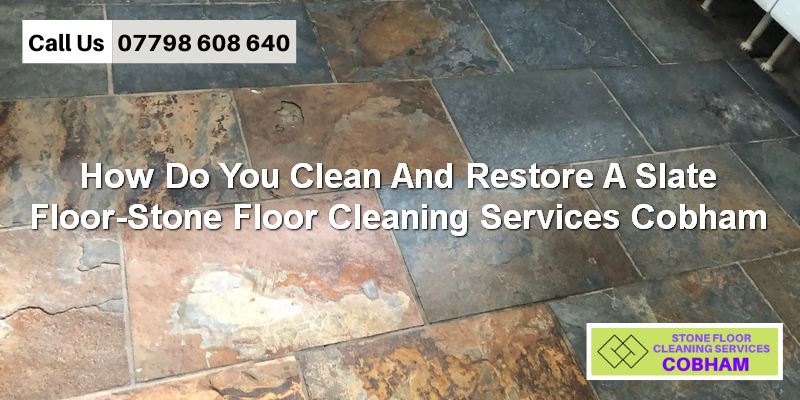How Do You Clean And Restore A Slate Floor?

Slate floors are a beautiful, functional and long-lasting addition to any home. But like any investment, they must be cared for properly to keep them looking their best. Regular cleaning and restoration of slate floors help maintain the longevity and aesthetic beauty of the stone and keep them looking as good as new.
The Benefits of Cleaning and Restoring a Slate Floor
Regular cleaning and restoration of slate floors can provide many benefits. It can help preserve the natural beauty of the stone, as well as increase its durability and longevity. Cleaning and restoring a slate floor can also help remove dirt, grime, and other debris that can accumulate over time, which can cause discolouration or staining. Additionally, it can help restore the stone's finish, making it look as good as new. Cleaning and restoring a slate floor can also reduce the risk of slips and falls by removing dirt or debris that can make the floor slippery.
Cleaning and restoring a slate floor can also help to protect the stone from damage caused by water, dirt, and other elements. Regular cleaning helps extend the floor's life and keeps it looking beautiful for years.
What Type of Cleaning Solution is Best for Slate Floors?
Many store-bought cleaning solutions are available for slate floors, but choosing one formulated for stone surfaces is essential. To ensure the longevity of your slate floor, choose a mild cleaner free from harsh chemicals or abrasives. Avoid using vinegar or bleach-based cleaners, which can damage the stone's surface.
When cleaning slate floors, using a soft-bristled brush or mop is essential to avoid scratching the surface. Additionally, it is vital to dry the floor after cleaning to prevent water spots. When using a store-bought cleaner, read the instructions carefully and follow the manufacturer's recommendations.
Professional vs DIY Slate Floor Cleaning and Restoration
When it comes to cleaning and restoring slate floors, there are two main options: professional or DIY. Professional cleaning services typically use specialized equipment and chemicals to deep clean and restore the stone's surface. They also offer sealant treatments to protect the floor from future damage. DIY cleaning methods typically involve basic cleaning with a store-bought cleaner and mild abrasive scrubbing with a brush or cloth. Sealants are available from local DIY stores.
When deciding between professional and DIY slate floor cleaning and restoration, comparing the cost, time, and effort involved is essential. Professional services are more costly but the best option for deep cleaning and restoring the slate. Professionals have the experience, equipment and materials to clean the floor more effectively than a homeowner can. They also have access to high-quality sealants and the experience of applying them. DIY methods can be more cost-effective but are less effective in restoring the floor.
How to Seal Slate Floors After Cleaning
Once the slate floor has been cleaned and restored, applying a sealant is essential to protect it from future damage. A good sealer will help keep dirt and grime from building on the stone's surface. Many store-bought sealers are available for stone floors, but choosing one designed explicitly for slate is essential.
When applying the sealant, working in small sections and avoiding overlapping strokes is crucial. Allow the sealer to dry completely before walking on the floor or placing the furniture back in the room. Reapply the sealant every few years to keep the slate floor looking its best.
How to Remove Stains from a Slate Floor
Stains from spills or other sources can be challenging to remove from a slate floor. The best way to remove stains is to try blotting them with a clean cloth or paper towel. Try a mild alkali slate cleaner if the stain does not come out with blotting. Rinse the floor thoroughly after using the cleaner. If the stain persists, you need to call on professional help.
Common Mistakes to Avoid When Cleaning Slate Floors
Several common mistakes should be avoided when cleaning slate floors. One of the most important is using too much water or harsh chemicals. Harsh chemicals will degrade the sealer and possibly damage the slate's surface.
It is important to regularly sweep or vacuum the slate floor to remove any dirt or debris that may have accumulated.
Don't use abrasive cleaning tools or materials on slate floors. Abrasive materials will scratch the stone's surface, leaving it dull and unattractive.
Tips for Maintaining a Clean and Restored Slate Floor
To maintain a clean and restored slate floor, it's important to regularly sweep or vacuum up any dirt or debris on the surface. Additionally, it's essential to use mats or rugs at entryways to help reduce dirt and debris from entering the house in the first place. Lastly, it's important to periodically reseal the floor with a sealant designed explicitly for slate. A sealer will help protect the stone from future damage and ensure that your slate floor looks as good as new for years to come.
Frequently Asked Questions
How do you rejuvenate slate floors?
If you don't want the natural dull finish, you can apply a colour enhancing sealer to highlight the colours in the slate. The finish will still be dull. If you also want a sheen finish, apply mid-sheen topical sealer.
Is slate flooring hard to clean?
Slate, like all stone floors needs regular cleaning to keep it in tip top condition. remove dry soil daily by sweeping or using a vacuum. damp mop 2 or 3 times a week with a Ph neutral cleaner to remove sticky spills.
Is it OK to steam clean slate floors?
Do not use steam cleaners on slate floors. The steam sill degrade the sealer and high temperature steam can cause flaking. Stick to vacuuming and mopping.